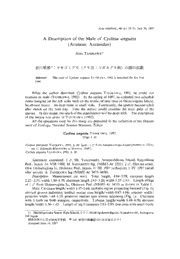
A Description of the Male of Cyclosa angusta(Araneae: Araneidae). PDF
Preview A Description of the Male of Cyclosa angusta(Araneae: Araneidae).
Acta arachnol., 46 (1): 29-31, July 30, 1997 A Description of the Male of Cyclosa angusta (Araneae: Araneidae) Akio TANIKAWA1 谷川明男1):ヤ セゴミグモ(ク モ目 コガネグモ科)の 雄の記載 Abstract The male of Cyclosa angusta TANIKAWA, 1992 is described for the first time. When the author described Cyclosa angusta TANIKAWA, 1992, he could not examine its male (TANIKAWA, 1992). In the spring of 1997, he collected two subadult males hanging on the orb webs built on the trunks of pine trees in Okinawajima Island, Southwest Japan. He kept them in small vials. Fortunately, the spiders became adult after moult on the next day. Thus the author could examine the male palp of the species. In this paper, the result of the examination will be dealt with. The description of the female was given in TANIKAWA (1992). All the specimens used for this study are deposited in the collection of the Depart- ment of Zoology, National Science Museum, Tokyo. Cyclosa angusta TANIKAWA, 1992 (Figs. 1-6) Cyclosa laticauda: TANIKAWA, 1992, p. 20. [part.: 1 & from Amami-oshima Island (NSMT-Ar 2321); nec C. laticauda BOSENBERG et STRAND, 1906.] Cyclosa angusta TANIKAWA, 1992, p. 26. Specimens examined. 1 c?, Mt. Yuwandake, Amami-oshima Island, Kagoshima Pref., Japan, 24-VIII-1989, M. SADAMOTO leg. (NSMT-Ar 2321). 2 Oku-no-sanso, Oku, Okinawajima Is., Okinawa Pref., Japan, 31-III-1997 (subadult), 1-IV-1997 (adult after moult), A. TANIKAWA leg (NSMT-Ar 3455-3456). Description. Measurement (in mm). Total length, 4.94-5.59; carapace length 2.22- 2.35; width 1.60-1.70; abdomen length 2.63-3.20, width 1.37-1.83. Length of legs of 1 o1 from Okinawajima Is., Okinawa Pref. (NSMT-Ar 3455) as shown in Table 1. Male. Carapace length/width 1.37-1.44, cephalic region projecting forward (Fig. 1); cervical groove indistinct; median ocular area length/width 0.87-1.06; anterior width/ posterior width 1.44-1.53; posterior median eyes almost adjoining (Fig. 1). Chelicera with 3 teeth on both margins, respectively. Labium length/width 0.48-0.50; sternum length/width 1.36-1.42. Length of leg I/carapace 2.83-2.93; first coxa with small hook; 1) Shichirigahama Senior High School, 2-3-1, Shichirigahama-higashi, Kamakura-shi, Kanagawa, 248 Japan T 248 ;:fF J 2-3-1 Accepted June 16, 1997 30 A. TANIKAWA Figs. 1-6. Cyclosa angusta TANIKAWA, 1992 (NSMT-Ar 3455). - 1. Male ce- phalothorax and abdomen, dosal view. 2. Male palp, prolateral view. 3. Tibia of male 2 nd leg, prolateral view. 4. Same, dorsal view. 5. Median apophysis of male palp (distal part). 6.Male abdomen, lateral view. (Scales: 0.25 mm.) Table 1. Measurement of leg segments of Cyclosa angusta TANIKAWA, 1992 (in mm; 6). retrolateral side of 1st femur distally with a row of 6-8 spines; spiniformation of 2 nd tibia as shown in Figs. 3-4. Male palp (Fig. 2): patella with one macroseta; median apophysis distally bent and bifurcated, basally with a wing-shaped lamella; embolus rostriform; paramedian apo- physis visible in prolateral view. Abdomen length/width 1.75-1.78, caudally with four tubercles (Figs. 1, 6). Coloration and markings in alcohol. Carapace dark brown. Abdomen light brown mottled with dark brown (Fig. 1). Range. Japan (Amami-oshima Island, Okinawajima Island and Iriomotejima Island). Remarks. As was mentioned in the previous paper (TANIKAWA, 1992), C. angusta seems to be closely related to Cyclosa laticauda BOSENBERG et STRAND, 1906. The shape of the male palpal organ of C. angusta is very similar to that of C. laticauda. Male of Cyclosa angusta 31 However, the males of these species can be separated from each other by the shape of abdomen. The caudal part of abdomen is vertically bifurcated in both the species. In C. laticauda, both tubercles are close to each other, while in C. angusta the upper tubercle is situated anteriorly (Fig. 6). A pair of dorsal tubercles on the anterior half of abdomen are distinct in C. laticauda, but indistinct in C. angusta (Fig. 6). Acknowledgments The author wishes to express his hearty thanks to Dr. Hirotsugu ONo, Department of Zoology, National Science Museum, Tokyo, for his constant guidance and for reading the manuscript of this paper. For supporting the field work in Okinawajima Island, he is deeply indebted to Mr. Takeshi SASAKI and Mr. Tsukasa KUWAE, Ryukyu University. 摘 要 qγcZo3α伽9襯 αTANIKAWA,1992ヤ セゴミグモの雄 を初めて記載 した. Reference TANIKAWA, A., 1992. A revisional study of the Japanese spiders of the genus Cyclosa MENGE. Acta arachnol., 41:11-85.
